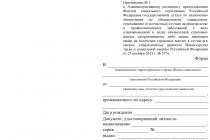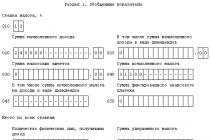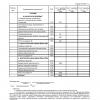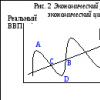"On participation in shared construction" obliges the developer to pay compensation to the shareholder for violation of the deadline for the transfer of the object. He does not establish its fixed value, but in Part 2 of Art. 6 FZ 214 specifies the formula for calculating the penalty:
1. For individual entrepreneurs and legal entities
Penalty \u003d C × K × C × 0.01 / 300;
2. For individuals(citizens)
Penalty \u003d C × K × C × 0.01 / 150;
where C - the price of an apartment according to the DDU; K - the number of days of delay; C is the refinancing rate of the Central Bank of the Russian Federation.
Important points in determining quantities
To avoid problems during the trial, you must initially correctly calculate the amount of the penalty.
C - the price of the object specified in the contract equity participation in construction. Not to be confused with the price from the cession agreement, if any.
K is the number of days between the start and end of the delay. The beginning of the period of violation of the deadline for the delivery of the object is defined as the first working date after the date of transfer of the apartment according to the DDU. If the transfer period is specified in the contract not as an exact date, but as a quarter, the first day of delay is considered to be the business day following the last day of the quarter. If the Act of acceptance and transfer of the apartment is signed, then its date will be the end date of the delay. If the apartment has not yet been transferred, then the current date at the time of the claim or claim should be indicated.
C is the refinancing rate of the Central Bank of the Russian Federation (since 2016, it has been equal to the key rate). Depending on the period for which the delay falls, it is more profitable to calculate the penalty at the rate at the time of fulfillment of obligations / as of the current date or at the periods of validity of the rates of the Central Bank of the Russian Federation. However, the difference in amounts can be significant.
Validity periods of the rates of the Central Bank of the Russian Federation in 2016-2017
|
Beginning of period |
End of period |
Bid |
|
present time |
Calculator for calculating the penalty according to the formula of law 214 FZ
Knowing all the necessary data, you can manually calculate the penalty using the above formula.
To check the correctness of your calculations or immediately find out the exact amount, use our online calculator. Just enter the required dates and the cost of the apartment and get the result.
The requirements for calculating the penalty are regulated by the Federal Law of December 30, 2004 No. 214-FZ “On Participation in Shared Construction apartment buildings". In practice, there are 2 procedures for its collection:
- pre-trial (by filing a claim with the developer);
- judicial (submission of a statement of claim to the court).
The procedure for recovery in court consists of the following steps:
- drawing up a claim, collecting documentation;
- filing a lawsuit in court, appointment of a court session by a judge;
- consideration of the case by the court;
- issuance of a court decision, receipt of a writ of execution by a participant shared construction.
Claim to the developer about violation of the deadlines for the delivery of the house In case of violation of the deadlines for the transfer of the apartment, established by the equity participation agreement (DDU), the shareholder may send a claim to the developer.
Penalty calculator for ddu (214 fz)
Yes, it should include:
- names of the parties;
- circumstances in connection with which there was a violation of the terms (with excerpts from the contract);
- the amount of the penalty (with a description of its calculation);
- requirements and deadlines for the payment of a penalty.
The following copies should be attached to the claim letter:
- passports of the participant of kindergarten;
- participation agreements;
- documents confirming the payment of payments by the shareholder.
If such a letter is drawn up after signing the acceptance certificate, then a copy of it is also attached to the claim. Due to this, a violation of the terms specified in the contract will be visible.
Penalty calculator in accordance with 214-FZ
- Calculation on the date of signing the act of acceptance and delivery of the object
- Calculation on the date of filing a claim (if the object is not transferred)
Calculation for each period of the rate
The first calculation option is more logical, so the courts, as a rule, are guided by this mechanism. A case from practice ⚖ Second example The amount under the DDU is 2,000,000 rubles.
Attention
Deadline for delivery of the apartment - no later than June 30, 2015. The deed of transfer was signed on September 30, 2016. The delay is counted from July 1, 2015. until September 30, 2016
It amounted to 458 calendar days. This period is divided into several, since the rate has changed, and we calculate the penalty by day using the same formula: , in rubles from 01.07.2015 to December 31, 2015 184 8.25% 202,400 from 01.01.2016 to 13.06.2016
Calculation of the penalty under the DDU (participation agreement) under Art. 6 of the law 214 fz
In fact, the penalty is monetary compensation for the use by the developer Money shareholder. The developer must pay this money in addition to the amount specified in the contract and paid to him by the equity holder for housing construction.
This issue is regulated by the law “On Participation in the Shared Construction of Apartment Buildings and Other Real Estate Objects ...” dated December 30, 2004 No. 214-FZ. Subscribe to our channel in Yandex.Zen! Subscribe to the channel The penalty is also paid if:
- the constructed dwelling does not meet the previously declared quality;
- money for the construction was attracted by a person who did not have the right to commit such actions.
The formula for calculating the penalty under an equity participation agreement According to Part.
2 tbsp.
Penalty for delay in renting an apartment under a share agreement
Important
Law No. 214-FZ: “the developer pays a participant in shared construction a penalty (penalty) in the amount of one three hundredth of the refinancing rate Central Bank Russian Federation effective on the day of fulfillment of the obligation, from the price of the contract for each day of delay. If a participant in shared construction is a citizen, the forfeit (penalty) provided for by this part shall be paid by the developer in double size».
It can be calculated independently, using special online services or by contacting specialists. ✔ Independently To calculate the penalty under an agreement concluded with citizens, the following formula: (price of the apartment under the contract) × (number of days of delay) × (refinancing rate) / 150 When calculating the penalty for entrepreneurs and legal entities, the amount of the penalty is halved.
Calculation of the penalty for dd according to 214 fz - rules, formula and calculator
Alexander Marushchenko Senior Associate But in legal practice, the interpretation of laws can be ambiguous. That is why we need lawyers who use all sorts of methods, arguments, evidence and documentary base to make the most advantageous decision in favor of the client.
Therefore, do not rush to immediately collect the first amount that comes across. Based on the specific case, taking into account the timing, periods and different interest rates, it is necessary to calculate the penalty by all possible ways, compare the results and decide how much to require. Important: when calculating, do not overdo it, proceed from the real state of affairs and financial condition developer, and demand a reasonable amount of the penalty. In this case, the court goes towards the plaintiff.
So, here is the main formula for calculating the penalty: CM \u003d SK x 1/300 SR x PP. Now let's look at the notation:
- SM is a penalty;
- SC - the amount of the contract;
- SR - refinancing rate;
- PP - the number of days of delay.
Now it is clear that the amount is calculated simply? But there are many nuances, in particular, the refinancing rate parameter.
The rate changes every few years, sometimes more often. In the penalty calculator for 214 FZ, the 2017 calculator uses 8.25 percent of the rate.
In the first half of 2016, it was 11%, and in the second - 10.5% per annum. Without knowing this, the calculated amount would be incorrect, so the virtual penalty calculator for 214 will show the correct result only if the calculation is carried out for a certain period, taking into account the refinancing rate that worked at that time.
Forfeit according to ddu calculation of forfeit
- the amount of money paid to the developer;
- the presence, reasons for the delay and its duration;
- the amount of the penalty and damages.
In most cases, the claims of the plaintiffs are satisfied both in full and in part. Compensation for non-pecuniary damage during the consideration of the case can be reduced, when determining its size, various circumstances that caused inconvenience to the shareholder are taken into account:
- long-term elimination of shortcomings of the shared construction object;
- refusal of the developer to meet the requirements specified in the claim or inspection sheet.
The developer has the right to force the shareholder to conclude an agreement on the postponement of the transfer of residential premises only if circumstances change significantly (Article 451 of the Civil Code of the Russian Federation).
Article 6 federal law 214 FZ there is no such thing as a key rate. Only the concept of the refinancing rate is used, and therefore there is some confusion when calculating interest on DDU.
The thing is that from 01/01/2016. The Central Bank of the Russian Federation by its Directive No. 3894-U dated 11.12.2015. equated the refinancing rate to the key rate. Thus, from 01/01/2016, the independent value of the refinancing rate for the purpose of calculating the penalty under 214 FZ is no longer applied.
It follows from this: - if the apartment was transferred under the act before 12/31/2015 inclusive, the penalty is calculated at the refinancing rate of 8.25%. - if the apartment was transferred under the act after 01/01/2016, the calculation is made at the key rate.
The specifics of the case have been highlighted in bold type. Similar judicial practice in cases of the Moscow City Court: N 33-7017 of 03/06/2014, N33-757 / 14 of 01/20/2015. The appeal ruling of the Moscow City Court opens by clicking on the image on several pages.
Info
Analysis of additional issues arising in the calculation of 214 FZ. From what price should we calculate: from the price of the DDU or from the price in the assignment (cession) agreement? The calculation is made from the price of the apartment specified in the share agreement, even if it is significantly less than the amount for which you purchased an apartment under an assignment agreement.
There is a logic here that is understandable even to a non-lawyer. Under the assignment agreement, the rights to claim the apartment and other rights under the assignment agreement were transferred to you. After registration of the assignment agreement, the assignor no longer has rights to the apartment, they passed to the assignee (to you) for certain money that you paid for the apartment to the assignor.
From 02/10/2020 Central Bank RF lowered the rate used in the calculation of the penalty, up to 6 percent per annum. Now, the calculation of interest on DDUs again becomes relevant, taking into account the periods of validity of the rates of the Bank of Russia.
We will collect a penalty, a fine, non-pecuniary damage, losses and compensation legal services. Free consultations by tel. 8-903-120-51-06 Daily from 9 a.m. to 11 p.m.














